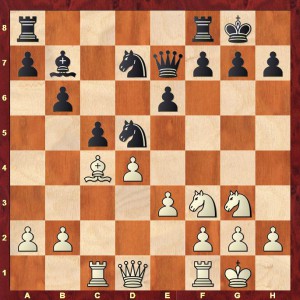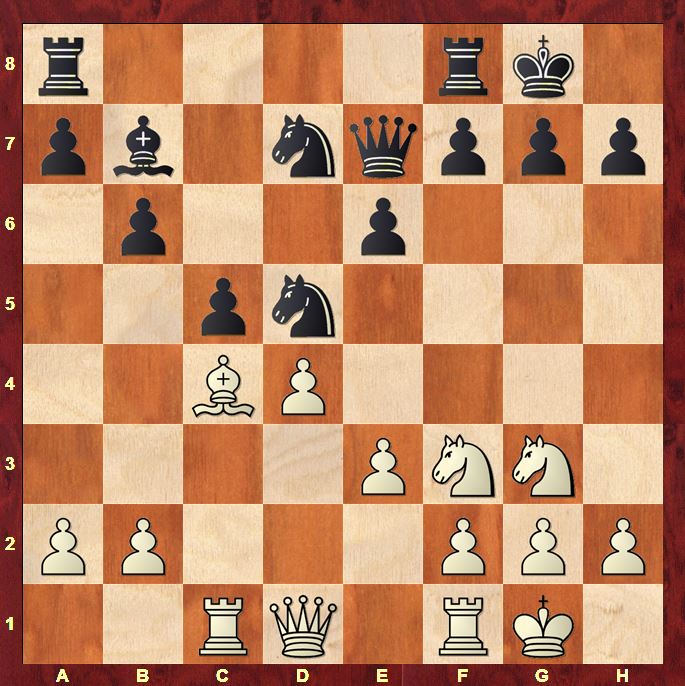One of the things that made Alekhine very frightening to play against was his inventiveness in the openings. His particular forte was provoking quick crises in solid-looking 1.d4 openings. Alekhine was a master at forcing the opponent to solve concrete problems an at unexpectedly early moment in the game. Without the buffer of modern opening theory to protect them, even the strongest players of his era were unable to cope with the enormous energy that Alekhine injected into his pieces in the opening phase. Vukovic put it very nicely in his classic work The Art of Attack: “Alekhine knew how to instil a little aggressiveness into his moves even in the opening and create some conditions for attack with a minimum of commitments. This is precisely where his skill lay, and it is this which is lacking in many masters”
His game annotations are full of such ideas and I came across one recently in his game against Maroczy in San Remo 1930. While reading the book on the train, an idea popped into my head. Could I be even more cunning than Alekhine and refute his idea? I was close, but I didn’t manage!

The game now continued…
14.e4 N5f6 15.Re1 cxd4 16.Bb5 Rfc8 17.Qxd4 Rc5 18.Bxd7 Nxd7 19.b4 Rxc1 20.Rxc1 Rc8
…which led to a balanced position. I’ll take a look at the rest of the game in a later post because it was a tough and interesting fight. However, here I want to take a look at Alekhine’s tricky alternative suggestion of
14.Bb5
Now to be honest, after 14…Rfd8, I don’t see any problems for Black at all, but what if Black just decides to play safe and liquidate at once with 14…cxd4?
15.e4!
Here we go! From a sleepy position a few moves ago, we’re right into Alekhine’s irrational world where any mistake can mean disaster!
It’s a very clever idea, and at first sight looks decisive: once the knight leaves d5, then White can invade on c7 with his rook. However, I spotted a couple of ideas and I thought I might be able to trap the trapper!
15…N5f6 16.Rc7
I now had 2 ideas:
1. 16…Rab8
Taking insouciance to extremes! I loved this move when I thought of it.
After A.17.Qxd4 my idea seems to work:
17…Rfc8 18.Rxd7
18.Rfc1 Ne8
18…Nxd7 19.Bxd7 Rd8
Here however, I didn’t quite scale the heights of genius!
I saw 20.Ne5 f6 21.Nf5 exf5 22.Qc4+ Kf8 but I couldn’t break 20.Rd1 Bc6 21.Ne5 Bxd7 22.Nxd7 Rbc8 23.Qa4 which just looks good for White. That’s when you need Stockfish!
20.Rd1 Bc6 21.Ne5 Bb5 22.a4 Bxd7 23.Nxd7 Rbc8 works!
Amazing! White no longer has Qa4! Black now threatens …Kh8 and …Rc7 winning the knight on d7!
24.a5 Kh8 25.axb6 axb6 26.Qa4 b5 27.Qa7
27.Qxb5 Rc7
27…Qb4
Stockfish sees Black as slightly better!
However, I also discovered something much better for White earlier on:
B.17.e5 Qd8
17…Bxf3 18.exf6 Qd6 19.Qc1 is the same as the main line
18.Qc1
18…Nc5 19.exf6 Qxc7 20.Qg5 g6 21.Qh6 mates
So it’s back to my second idea after 16.Rc7:
2. 16…Qd8 17.Rxb7 Nc5
This was what I had spotted originally: the rook on b7 is trapped! However, White has a way of extricating himself with advantage from his predicament:
18.Bc6 Qc8
18…Nxb7 19.Bxb7 Rb8 20.Bc6 is good for White. 20…Qc7 (20…e5 21.Nxe5 Qd6 22.f4; 20…Rc8 21.Bb5 e5 22.Nxe5 Rc5 23.Nc6 Qc7 24.Nxd4 Rd8 25.a4 Qd6 26.Nge2 I needed Stockfish to be sure of this one! White is just 2 pieces for a rook up!) 21.Ba4 e5 22.Qd2 Rbc8 23.Qg5 is a Stockfish spot: e5 is impossible to defend!
19.Rxf7 Rxf7 20.Bxa8 Qxa8 21.Ng5 Rd7 22.e5
is pleasant for White.
So I didn’t quite manage to trick Alekhine. Not going to stop me trying though!




1 Comment on “Alekhine’s Themes – at you right from the opening!”